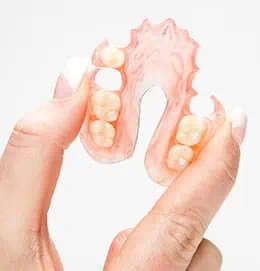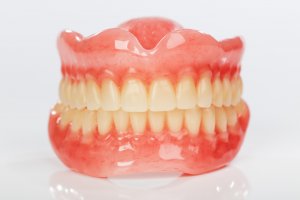There are many types of dentures available, and it can sometimes be difficult to know which is the right one for your mouth. If you are struggling to understand the different options for dentures, you are in the right place. Dentaly.org is here to help dental patients make the best, most informed choice possible.
Simply put, dentures are used as artificial, replacement teeth. They fill the gaps left by any missing teeth and can be broadly categorised as:
- Complete: dentures made to replace a full set of teeth
- Partial: one or more false teeth to fill the gaps between your existing teeth
But beyond this, there is the choice of removable vs. implant-supported, as well as various materials – each with its own pros and cons.
This page contains all of the information you require to make the best informed decision on which type of denture is right for you. No matter if you are looking for comfort, ease of cleaning or the right cost, you’ll have your natural-looking smile back in no time!
In This Article
Why are there so many types of dentures?

It’s not so long ago that patients with missing teeth had very limited choices. However, dental innovation has brought about increased options that are available if you opt for private treatment. Traditional dentures made from acrylic and metal are still available, which are the type provided by the NHS.
Here are some factors which will determine the best type of dentures for you:
- How many teeth you are missing
- Whether you’d prefer removable or fixed, implant-supported dentures
- Whether you need very natural-looking dentures for a front tooth
- Your budget
- Your overall oral health
So, with this in mind, let’s take a look at some of the different types available.
Complete dentures

A complete set of dentures may be needed if you are missing all of your original teeth. This means replacing all of your natural teeth with removable false teeth, in both the upper and lower jaw.
Typically made from acrylic, these conventional dentures are shaped to your jaw, following the removal of any remaining teeth and after your gums have begun to heal. This process can take between 8 to 10 weeks.
Complete dentures can be secured in place using a dental adhesive, and offer a comfortable way to improve your smile and to support eating in the way that you are used to.
Upper dentures
The upper denture is held in place in the upper jaw using a maxillary plate, which is usually made of metal, and shaped to fit the roof of your mouth. This plate supports an acrylic, plastic base, the “gum” to which your new false teeth are fitted.
Lower dentures
In a lower denture, your false teeth are attached to a plastic plate, which is supported by your gums, and may be held in place by a denture adhesive. The lower jaw and gums change shape over time, and you will need to visit the dentist every few years to check your denture fit.
If you have loose dentures or they no longer fit, they may either need to be adjusted by a dental technician or your prosthodontist may replace them with a new set.

Partial dentures
Partial dentures are used if you are missing some teeth but some natural teeth remain. These dentures consist of a plastic bridge and have metal clasps that hold them in place, enabling them to be fitted comfortably around your existing teeth. Both upper and lower sets of partial dentures are available, as well as single tooth dentures.
A partial denture set is coloured to match your natural teeth. Traditional removable partial dentures are made from more rigid materials such as chrome. There are more modern flexible alternatives made with nylon are now available.
Immediate dentures
If you’d prefer not to spend any time with gaps in your teeth, you may be eligible for immediate dentures. This type of denture can be made before any of a patient’s teeth are removed, and so is available to be worn during the healing process. Wearing immediate dentures allows full use of your mouth until your permanent dentures are complete.
As the gum tissue heals, there is a change in shape, so immediate dentures often need adjusting over time. That’s why this type of denture is usually used as a temporary measure, until a complete set of conventional dentures are made.
Fixed dentures (using dental implants)
Dental implants are an alternative to traditional dentures, and can used to replace a single tooth, multiple missing teeth or even as support for a set of permanent dentures.
Dental implants work by using a screw to fix an artificial tooth to the jaw bone. This secures the false tooth, holding the denture in place, and so providing a more natural look. Implants can last much longer than traditional dentures, so you won’t have to worry about replacing them.
A dental implant may be used to permanently fix dentures in place, providing more stability than removable dentures. Many dental patients choose this option as they have concerns about their dentures slipping out of place.

As fixed dentures are held securely in place, they are easier to clean than traditional dentures and may be brushed like ordinary teeth. In addition, some patients find them more comfortable to wear, as they don’t rub against the gum.
It is possible to use dental implants to provide a full set of artificial teeth, though this will cost more than other, traditional types of full dentures. Fixed dentures are available in two types; they may be either implant-supported or implant-retained.
Implant-supported dentures
Implant-supported dentures work by attaching a complete set of dentures to dental implants, using either a metal bar or individual ball attachments. Between four and six implants are used, which support the complete denture.
Implant-retained dentures
This type of denture also called ‘snap-on dentures’, works by attaching a removable set of dentures to only one or two dental implants. This provides the benefit of easy removal and cleaning. It’s also a cheaper option than dentures that need more implants.
Cleaning
Whichever type of denture you choose, it is important for your oral health to keep them clean.
Removable dentures need to be cleaned thoroughly every day, as instructed by your dentist. This usually involves placing them in a glass of water or cleaning solution overnight. However, it is not recommended that you leave your dentures in Steradent overnight, so make sure to read product manufacturer guidelines first.
Fixed implant dentures can be brushed and cleaned just like natural teeth.
Conclusion
There are many different types of dentures available to choose from. The best choice for you depends on your own specific needs and previous dentistry.
Do you require full dentures? Or just an upper or lower set? Would you prefer a metal framework or more flexible dentures?
Consider the look, feel and cost of the various types of dentures available, and which is the most suited to your own oral health. It is your mouth after all. Always remember, if any problems arise with your dentures, we recommend you seek the advice of a dentist.




